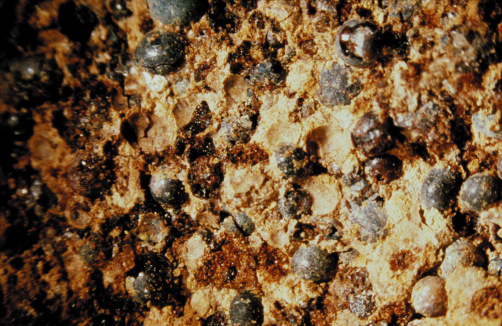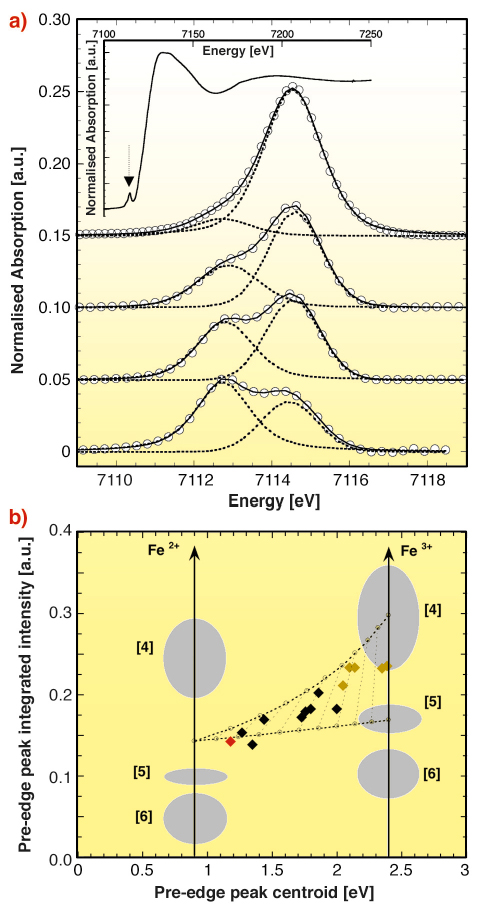- Home
- Users & Science
- Scientific Documentation
- ESRF Highlights
- ESRF Highlights 2005
- High Resolution and Resonance Scattering
- Iron Oxidation State in Impact Glass by High-resolution XANES Spectroscopy: Implications on the Formation Conditions
Iron Oxidation State in Impact Glass by High-resolution XANES Spectroscopy: Implications on the Formation Conditions
An impact event marking the limit between the Cretaceous and Tertiary (K/T) ages resulted in the formation of a ~ 180 km wide impact crater and possibly triggered the K/T mass extinction event. The impact event distributed a huge mass of ejecta material worldwide, including impact glass spherules resulting from the quenching of molten target rock. While most of the glassy spherules worldwide are almost completely recrystallised, fresh unaltered impact glass can be recovered at few sites, e.g., at Beloc, Haiti and Mimbral, Mexico. Three glass varieties have been found so far at Haiti: black, yellow, and HSiK impact glass. Black impact spherules consist of silicate glass of andesitic composition (63 wt% SiO2, 7 wt% CaO), whereas the much rarer yellow variety consists of silicate glass (49 wt% SiO2) with high Ca (about 25 wt% CaO) and S contents (0.5 to 2 wt% S). The HSiK glass is represented by a single sample with very high Si content (86 wt% SiO2) and especially low Ca content (0.38 wt% CaO). Although several studies on the chemical and isotopic composition of these impact glasses exist, almost no studies on the Fe coordination number and oxidation state have been reported. Such studies are however of utmost importance to reconstruct the oxygen fugacity conditions prevailing during impact melt formation.
 |
|
Fig. 24: Microphotograph of black impact glass spherules. |
We examined the iron local environment in a suite of impact glasses (Figure 24) from the Cretaceous-Tertiary (K/T) boundary section at Beloc spanning the widest possible variety of glasses (9 black impact glasses, 5 yellow impact glasses, and the only HSiK impact glass available so far) by Fe K-edge high-resolution X-ray Absorption Near Edge Structure (XANES) spectroscopy at the ID26 beamline. The very high intensity and collimation of the X-ray beam allowed us to collect data on glass samples as small as 100 micrometres. The pre-edge peaks of our XANES spectra (Figure 25) display noticeable variations which are indicative of significant changes in the Fe oxidation state, spanning a wide range from about 20 to 100 mol% trivalent Fe. All data plot along a trend, falling between two mixing lines joining a point calculated as the mean of a group of tektites studied so far (consisting of 4- and 5- coordinated Fe2+) to [4]Fe3+ and [5]Fe3+, respectively. Thus, the XANES spectra can be interpreted as a mixture of [4]Fe2+, [5]Fe2+, [4]Fe3+ and [5]Fe3+. There is no evidence for six-fold coordinated Fe; however, its presence in small amounts cannot be excluded from XANES data alone. Our observations are explained by a very large variety of oxygen fugacity conditions prevailing during melt formation. Furthermore, there is a clear positive relationship between the Fe3+/(Fe2+ + Fe3+) ratio and the Ca content of the studied glasses, suggesting that the Fe oxidation state was affected by the variable contribution of the Ca-sulphate bearing sedimentary rocks overlying the target rock at the impact site.
 |
|
Fig. 25: a) Pre-edge peaks of Fe K-edge XANES spectra of impact glasses form the K/T boundary layer. The calcium concentration in the samples increases from bottom to top spectra. The experimental data (empty circles) are shown along with the fitted components (dashed line) and their sum (solid line). In the inset the XANES spectrum of a sample is shown. The arrow points to the pre-edge region. b) Plot of the pre-edge peak integrated intensity vs. centroid energy (zero refers to the edge energy of metallic iron). Diamond symbols refer to the samples studied here (black, yellow and red for black, yellow and HSiK spherules respectively). The shaded ellipses indicate the field of data occupied by Fe model compounds of known oxidation state and coordination number (Giuli et al., 2005). Also shown are the mixing lines (dashed lines + circles) between [4]Fe3+ or [5]Fe3+ and Fe2+ in a mixture of 4- and 5-fold coordinated sites. |
References
[1] G. Giuli, S.G. Eeckhout, E. Paris, C. Koeberl and G. Pratesi, Meteoritics and Planetary Science, 40, 1575-1580 (2005)
Principal Publication and Authors
G. Giuli (a), S.G. Eeckhout (b), E. Paris (a), C. Koeberl (c), and G. Pratesi (d) (2006) (in preparation).
(a) Dipartimento di Scienze della Terra, Università di Camerino (Italy)
(b) ESRF
(c) Department of Geological Sciences, University of Vienna (Austria)
(d) Dipartimento di Scienze della Terra, Università di Firenze (Italy)



